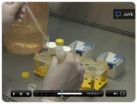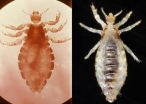(Press-News.org) Up to 30% of the world's population is infected with Tuberculosis (TB), but in many areas of the world, TB diagnosis still relies on insensitive, poorly standardized, and time-consuming methods. A new diagnostic tool, endorsed by the World Health Organization (WHO), may change that. Dr. Thomas Bodmer shows how it's done in the Journal of Visualized Experiments (JoVE).
Currently, TB is diagnosed through either a skin test, which produces a small bump on the patient's arm when administered and needs to be checked after 72 hours, and through smear microscopy, a method that was developed over a century ago. The new test is fully automated and takes about an hour and a half to give results. It is also able to determine if the patient is infected with a multidrug-resistant strain of the bacteria.
"The Xpert MTB/RIF assay is intended for use with specimens from patients for whom there is suspicion of pulmonary tuberculosis and who fulfill the criteria outlined in the accompanied text," said Dr. Bodmer, who co-authored the article.
WHO endorsed the test in 2010, and is working to roll it out across tuberculosis-affected countries. An important aspect of this is training people to use the device, and the JoVE video-article will help with standardization. JoVE is the only peer reviewed, PubMed-indexed science journal to publish all of its content in both text and video format.
"TB is one of the most deadly infectious diseases worldwide and accurate and rapid diagnosis is essential for timely and proper treatment. This test is expected to dramatically improve the diagnosis of TB," said JoVE Science Editor, Dr. Charlotte Frank Sage. "Publication of the protocol in JoVE allows researchers around the world to see a detailed demonstration of this diagnostic tool and will aid in establishing this technology in their laboratories and clinics."
INFORMATION:
The article will be published on April 9, and can be seen here: http://www.jove.com/video/3547/diagnosing-pulmonary-tuberculosis-the-xpert-mtb-rif-test
About The Journal of Visualized Experiments:
The Journal of Visualized Experiments (JoVE) is the first and only Pubmed and Medline indexed academic journal devoted to publishing research in the biological sciences in video format. Using an international network of videographers, JoVE films and edits videos of researchers performing new experimental techniques at top universities, allowing students and scientists to learn them much more quickly. As of January 2012 JoVE has released 59 monthly issues including over 1500 video-protocols on experimental approaches in developmental biology, neuroscience, microbiology and other fields.
A better tool to diagnose tuberculosis
2012-04-10
ELSE PRESS RELEASES FROM THIS DATE:
WirelessTimeClock.com Launches Redesigned Site
2012-04-10
WirelessTimeClock.com, a trusted source for web-based time clocks, has re-launched its website (http://www.wirelesstimeclock.com) with a more intuitive and streamlined design, promising a more enriching experience for businesses searching for reliable employee time clocks and time and attendance management solutions.
"Our customers have been asking for a more intuitive, resourceful site," says Scott Tobin, owner of WirelessTimeClock.com. "We wanted to make sure they could find exactly the clocks and monthly plans that would fit their business needs."
With ...
High-resolution atomic imaging of specimens in liquid by TEM using graphene liquid cell
2012-04-10
Daejeon, the Republic of Korea, April 9, 2012—The Korea Advanced Institute of Science and Technology (KAIST) announced that a research team from the Department of Materials Science and Engineering has developed a technology that enables scientists and engineers to observe processes occurring in liquid media on the smallest possible scale which is less than a nanometer.
Professor Jeong Yong Lee and Researcher Jong Min Yuk, in collaboration with Professor Paul Alivisatos's and Professor Alex Zettl's groups at the University of California, Berkeley, succeeded in making ...
Normalizing tumor blood vessels improves delivery of only the smallest nanomedicines
2012-04-10
Combining two strategies designed to improve the results of cancer treatment – antiangiogenesis drugs and nanomedicines – may only be successful if the smallest nanomedicines are used. A new study from Massachusetts General Hospital (MGH) researchers, appearing in Nature Nanotechnology, finds that normalizing blood vessels within tumors, which improves the delivery of standard chemotherapy drugs, can block the delivery of larger nanotherapy molecules.
"We found that vascular normalization only increases the delivery of the smallest nanomedicines to cancer cells," says ...
SDO and STEREO spot something new on the sun
2012-04-10
One day in the fall of 2011, Neil Sheeley, a solar scientist at the Naval Research Laboratory in Washington, D.C., did what he always does – look through the daily images of the sun from NASA's Solar Dynamics Observatory (SDO).
But on this day he saw something he'd never noticed before: a pattern of cells with bright centers and dark boundaries occurring in the sun's atmosphere, the corona. These cells looked somewhat like a cell pattern that occurs on the sun's surface -- similar to the bubbles that rise to the top of boiling water -- but it was a surprise to find this ...
Atlanta Hardwood Flooring Can Be "Baby-Proof" If Done By FlooringAtlantaNow.com
2012-04-10
It shouldn't be surprising to those who have children, that Atlanta Hardwood Flooring is constantly in harm's way from rambunctious babies! The experts at FlooringAtlantaNow are truly masters of the trade, and most recommend using more durable types of wood for high-traffic areas of your home which are prone to scratches or abrasions.
Most Atlanta Flooring specialists agree that winter is the best time to do these types of installations and upgrades to your home. Because metro-Atlanta is known for its mild winters, the season offers a perfect climate which tends to be ...
Black flies may have a purpose after all
2012-04-10
Athens, Ga. – Black flies drink blood and spread disease such as river blindness—creating misery with their presence. A University of Georgia study, however, proves that the pesky insects can be useful.
Don Champagne, an entomology professor with the UGA College of Agricultural and Environmental Sciences, discovered a way to use the black fly's blood-sucking tactics for medical advancement. The results of his research were published in the journal PLoS One.
"In order to feed on blood, these insects have to contend with our natural defense agents against blood loss—like ...
Sexual reproduction brings long-term benefits, study shows
2012-04-10
Courtship rituals can be all-consuming, demanding time and effort – but now scientists have discovered why it might be worth it.
Attracting a mate – which can take significant effort, such as in a peacock's show of feathers or the exhaustive rutting of stags – can produce benefits for a species in the long term, a study suggests.
Scientists have shown that animals and plants which reproduce sexually are at a considerable advantage to those species – such as some insects and reptiles – that reproduce without a partner.
Researchers at the University of Edinburgh studied ...
Genetic regulator of fat metabolism and muscle fitness discovered
2012-04-10
While exercise is accepted universally as the most beneficial prescription physicians can write for patients, little is known about the molecular mechanisms that generate its widespread health benefits. Researchers from Case Western Reserve School of Medicine have shed light on this mystery by discovering that a genetic factor, Kruppel-like Factor 15 (KLF15), governs the body's ability to burn fat during exercise.
Previous research from the laboratory of Mukesh Jain, MD, FAHA, identified the importance of KLF15 in the metabolism of two of the three basic nutrients used ...
Head and body lice appear to be the same species, genetic study finds
2012-04-10
CHAMPAIGN, Ill. — A new study offers compelling genetic evidence that head and body lice are the same species. The finding is of special interest because body lice can transmit deadly bacterial diseases, while head lice do not.
The study appears in the journal Insect Molecular Biology.
Scientists have long debated whether human head and body lice are the same or different species. The head louse (Pediculus humanus capitis) is a persistent nuisance, clinging to and laying its eggs in the hair, digging its mouthparts into the scalp and feeding on blood several times a ...
A bit touchy: Plants' insect defenses activated by touch
2012-04-10
HOUSTON -- (April 9, 2012) -- A new study by Rice University scientists reveals that plants can use the sense of touch to fight off fungal infections and insects. The study, which will be published in the April 24 issue of Current Biology, finds that plant defenses are enhanced when plants are touched.
"From previous studies, we knew that plants change their growth in response to touch but we didn't know how these growth changes were activated," said Wassim Chehab, a faculty fellow in Rice's Department of Biochemistry and Cell Biology and lead author of the new study. ...




